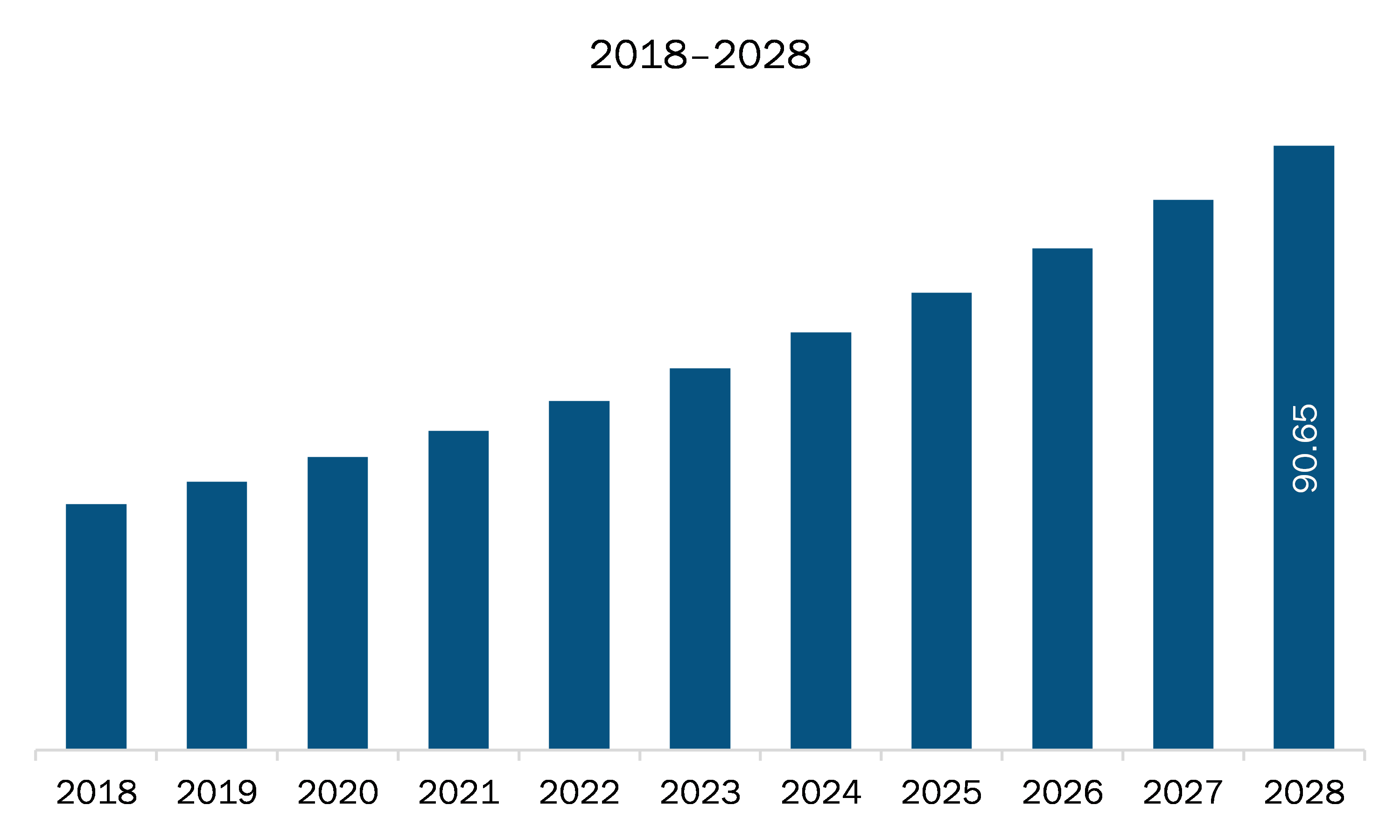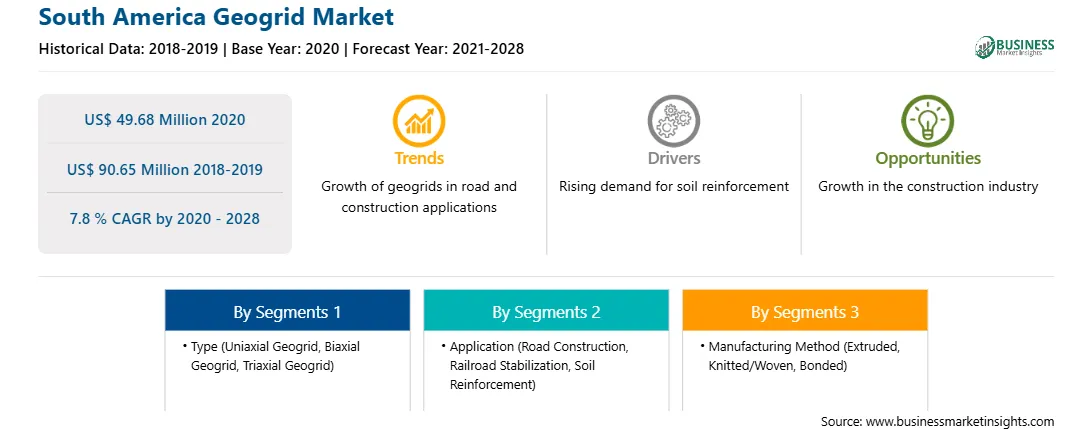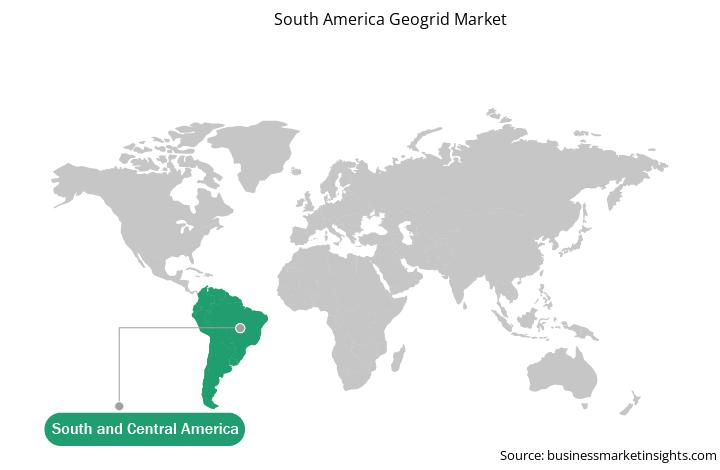The South America geogrid market is a highly fragmented market with the presence of considerable regional and local players providing numerous solutions for companies investing in the market arena. The use of natural geogrid for construction purpose as well soil reinforcement has been increasing. A natural geogrid or geotextile is one which includes alternating layers that is made from live branch cuttings and the compacted soil with geotextiles (natural or synthetic) wrapped around each soil lift. The system is also known as "fabric encapsulated soil" or "live soft gabion. " The natural geogrid helps in trapping the sediment as well as reinforces and rebuilds the streambank. These natural geogrids can be used to establish riparian vegetation if the geogrids are properly designed and installed. These geogrids are mostly applicable on steeper and higher slopes as well as helps in restoring the outside bends where erosion can become a problem. The effectiveness of natural geogrid will increase with time, as the vegetations become permanently established.
In case of COVID-19, in South America, especially Brazil, witnessed an unprecedented rise in number of coronavirus cases, which led to the discontinuation of geogrid manufacturing activities. Downfall of other chemical and materials manufacturing sectors has subsequently impacted the demand for geogrid during the early months of 2020. Moreover, decline in the overall reinforcement materials manufacturing activities has led to discontinuation of geogrid manufacturing projects, thereby reducing the demand for geogrid. Similar trend was witnessed in other South American countries, i.e., Argentina, Colombia, Peru, Chile and Ecuador. However, the countries are likely to overcome thus drop in demand with the economic activities regaining their pace, especially in the beginning of the 2021.

Strategic insights for the South America Geogrid provides data-driven analysis of the industry landscape, including current trends, key players, and regional nuances. These insights offer actionable recommendations, enabling readers to differentiate themselves from competitors by identifying untapped segments or developing unique value propositions. Leveraging data analytics, these insights help industry players anticipate the market shifts, whether investors, manufacturers, or other stakeholders. A future-oriented perspective is essential, helping stakeholders anticipate market shifts and position themselves for long-term success in this dynamic region. Ultimately, effective strategic insights empower readers to make informed decisions that drive profitability and achieve their business objectives within the market.

| Report Attribute | Details |
|---|---|
| Market size in 2020 | US$ 49.68 Million |
| Market Size by 2028 | US$ 90.65 Million |
| Global CAGR (2020 - 2028) | 7.8 % |
| Historical Data | 2018-2019 |
| Forecast period | 2021-2028 |
| Segments Covered |
By Type
|
| Regions and Countries Covered | South and Central America
|
| Market leaders and key company profiles |
The geographic scope of the South America Geogrid refers to the specific areas in which a business operates and competes. Understanding local distinctions, such as diverse consumer preferences (e.g., demand for specific plug types or battery backup durations), varying economic conditions, and regulatory environments, is crucial for tailoring strategies to specific markets. Businesses can expand their reach by identifying underserved areas or adapting their offerings to meet local demands. A clear market focus allows for more effective resource allocation, targeted marketing campaigns, and better positioning against local competitors, ultimately driving growth in those targeted areas.

The geogrid market in South America is expected to grow from US$ 49.68 million in 2020 to US$ 90.65 million by 2028; it is estimated to grow at a CAGR of 7.8 % from 2020 to 2028. The companies which are manufacturing geogrids are always looking to innovate the products provided by them. Previously, geogrids were usually made form materials such as polyester and propylene, but now high-density polyethylene materials are also used to produce geogrids. The geogrids made from HDPE resist elongation when they are subjected to heavy loads for long period. Due to HDPE resins these kinds of geogrids are mostly used with a variety of backfill materials that includes recycled concrete as well as on-site soils. The companies are also providing geogrids that can be customized and can be produced according to specific roll lengths as well as the widths and grid aperture/opening sizes without making any comprise on the structural integrity. Thus, such innovations are going to be the future of the geogrid industries. For instance, HUESKER has produced the world's first geogrid which is made from 100% recycled PET. With the introduction of the new product, the company is basically focusing on providing more environmentally friendly solutions which will help in conserving the natural resources during production. Strata provides StrataGrid which is a polyester, flexible, high-performance geogrid that is mostly used in soil reinforcement and other civil engineering applications.
Based on type the biaxial geogrid segment accounted for the largest share of the South America geogrid market in 2019. Based on application, the road construction segment held a larger market share of the South America geogrid market in 2019. Based on manufacturing method, the extruded segment held a larger market share of the South America geogrid market in 2019. Biaxial geogrid is a type of geogrid which is made from high polymer. Biaxial geogrid consists of high tensile strength which is in both transverse and longitudinal directions. This type of geogrid is basically made through the process of extruding, punching, sheet forming and stretching. This type of geogrid basically provides good bearing capacity which can enhance soil structure and prevent soil erosion. This type of geogrid is often used in road construction to prevent the road from reflective and fatigue cracking. Biaxial geogrid is used to improve the long-term durability of the subgrade as well as reduces road maintenance costs. Geogrids also provides support for the construction of access roads, highways and applications on weak subgrades which earlier required expensive over-excavating and replacing. This type of geogrid has good resistance to long term degradation which makes it suitable for various applications, such as embankment reinforcement, soil stabilization, slope protection, wall reinforcement, and other permanent load bearing foundation reinforcement which in turn lead to an increased demand for biaxial geogrid. These products are mostly used in subbase reinforcement, soil stabilization, foundation engineering, and highway construction applications.
A few major primary and secondary sources referred to for preparing this report on the South America geogrid market are company websites, annual reports, financial reports, national government documents, and statistical database, among others. Major companies listed in the report include Tensar Corporation, Carthage Mills, Huesker Synthetic GmBH, Naue GmBH And Co. Kg, Tmp Geosynthetics, BPM Geosynthetics, Bostd Geosynthetics Qingdao Ltd, Strata Systems, Inc. and Reed & Graham Inc.
The South America Geogrid Market is valued at US$ 49.68 Million in 2020, it is projected to reach US$ 90.65 Million by 2028.
As per our report South America Geogrid Market, the market size is valued at US$ 49.68 Million in 2020, projecting it to reach US$ 90.65 Million by 2028. This translates to a CAGR of approximately 7.8 % during the forecast period.
The South America Geogrid Market report typically cover these key segments-
The historic period, base year, and forecast period can vary slightly depending on the specific market research report. However, for the South America Geogrid Market report:
The South America Geogrid Market is populated by several key players, each contributing to its growth and innovation. Some of the major players include:
The South America Geogrid Market report is valuable for diverse stakeholders, including:
Essentially, anyone involved in or considering involvement in the South America Geogrid Market value chain can benefit from the information contained in a comprehensive market report.